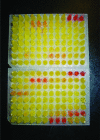Large-scale transposon mutagenesis of Photobacterium profundum SS9 reveals new genetic loci important for growth at low temperature and high pressure
- PMID: 18156275
- PMCID: PMC2258685
- DOI: 10.1128/JB.01176-07
Large-scale transposon mutagenesis of Photobacterium profundum SS9 reveals new genetic loci important for growth at low temperature and high pressure
Abstract
Microorganisms adapted to piezopsychrophilic growth dominate the majority of the biosphere that is at relatively constant low temperatures and high pressures, but the genetic bases for the adaptations are largely unknown. Here we report the use of transposon mutagenesis with the deep-sea bacterium Photobacterium profundum strain SS9 to isolate dozens of mutant strains whose growth is impaired at low temperature and/or whose growth is altered as a function of hydrostatic pressure. In many cases the gene mutation-growth phenotype relationship was verified by complementation analysis. The largest fraction of loci associated with temperature sensitivity were involved in the biosynthesis of the cell envelope, in particular the biosynthesis of extracellular polysaccharide. The largest fraction of loci associated with pressure sensitivity were involved in chromosomal structure and function. Genes for ribosome assembly and function were found to be important for both low-temperature and high-pressure growth. Likewise, both adaptation to temperature and adaptation to pressure were affected by mutations in a number of sensory and regulatory loci, suggesting the importance of signal transduction mechanisms in adaptation to either physical parameter. These analyses were the first global analyses of genes conditionally required for low-temperature or high-pressure growth in a deep-sea microorganism.
Figures





Similar articles
-
Insights into piezophily from genetic studies on the deep-sea bacterium, Photobacterium profundum SS9.Ann N Y Acad Sci. 2010 Feb;1189:143-8. doi: 10.1111/j.1749-6632.2009.05178.x. Ann N Y Acad Sci. 2010. PMID: 20233381 Review.
-
Insights into the initiation of chromosome II replication of the pressure-loving deep-sea bacterium Photobacterium profundum SS9.Microbiology (Reading). 2018 Jun;164(6):920-933. doi: 10.1099/mic.0.000663. Epub 2018 May 14. Microbiology (Reading). 2018. PMID: 29757128
-
RNA arbitrarily primed PCR survey of genes regulated by ToxR in the deep-sea bacterium Photobacterium profundum strain SS9.J Bacteriol. 2001 Mar;183(5):1688-93. doi: 10.1128/JB.183.5.1688-1693.2001. J Bacteriol. 2001. PMID: 11160100 Free PMC article.
-
An rpoE-like locus controls outer membrane protein synthesis and growth at cold temperatures and high pressures in the deep-sea bacterium Photobacterium sp. strain SS9.Mol Microbiol. 1995 Aug;17(4):713-26. doi: 10.1111/j.1365-2958.1995.mmi_17040713.x. Mol Microbiol. 1995. PMID: 8801425
-
Microbial adaptations to the psychrosphere/piezosphere.J Mol Microbiol Biotechnol. 1999 Aug;1(1):93-100. J Mol Microbiol Biotechnol. 1999. PMID: 10941790 Review.
Cited by
-
Global biogeography of SAR11 marine bacteria.Mol Syst Biol. 2012 Jul 17;8:595. doi: 10.1038/msb.2012.28. Mol Syst Biol. 2012. PMID: 22806143 Free PMC article.
-
Mapping Transposon Insertions in Bacterial Genomes by Arbitrarily Primed PCR.Curr Protoc Mol Biol. 2017 Apr 3;118:15.15.1-15.15.15. doi: 10.1002/cpmb.38. Curr Protoc Mol Biol. 2017. PMID: 28369678 Free PMC article.
-
Effects of hydrostatic pressure on growth and luminescence of a moderately-piezophilic luminous bacteria Photobacterium phosphoreum ANT-2200.PLoS One. 2013 Jun 20;8(6):e66580. doi: 10.1371/journal.pone.0066580. Print 2013. PLoS One. 2013. PMID: 23818946 Free PMC article.
-
Metabolic Basis for Mutualism between Gut Bacteria and Its Impact on the Drosophila melanogaster Host.Appl Environ Microbiol. 2019 Jan 9;85(2):e01882-18. doi: 10.1128/AEM.01882-18. Print 2019 Jan 15. Appl Environ Microbiol. 2019. PMID: 30389767 Free PMC article.
-
Differential analysis of transcriptome of psychrophilic bacteria under different culture temperatures.Technol Health Care. 2024;32(4):2251-2264. doi: 10.3233/THC-231022. Technol Health Care. 2024. PMID: 38517814 Free PMC article.
References
-
- Allen, E. E. 2002. Piezophysiology of membrane-based adaptations in the deep-sea bacterium Photobacterium profundum strain SS9. University of California, San Diego, La Jolla.
-
- Allen, E. E., and D. H. Bartlett. 2002. Structure and regulation of the omega-3 polyunsaturated fatty acid synthase genes from the deep-sea bacterium Photobacterium profundum strain SS9. Microbiology 1481903-1913. - PubMed
Publication types
MeSH terms
Substances
LinkOut - more resources
Full Text Sources

